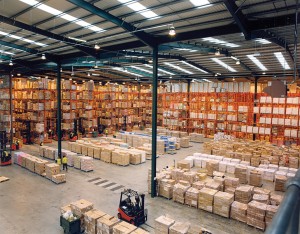 Your products may have different work content on your production line, which may make your line less efficient. One possible solution is Mixed Model Sequencing, a way to adjust the sequencing of your products to make the average work content stable. In previous posts I looked at the basics, at how to avoid the problem in the first place and how to play with capacity. However, especially for large complex lines (i.e., automotive), sequencing is often a suitable approach to manage different work contents.
Your products may have different work content on your production line, which may make your line less efficient. One possible solution is Mixed Model Sequencing, a way to adjust the sequencing of your products to make the average work content stable. In previous posts I looked at the basics, at how to avoid the problem in the first place and how to play with capacity. However, especially for large complex lines (i.e., automotive), sequencing is often a suitable approach to manage different work contents.
Leveling
Mixed Model Sequencing – Adjust Capacity
 Production lines with a product mix may have different workloads at different stations for different products. This can cause waste. In this third post in the series I will look at options on how to adjust the available capacity to ease this problem. In my next post I will look at Mixed Model Sequencing to adjust workload differences.
Production lines with a product mix may have different workloads at different stations for different products. This can cause waste. In this third post in the series I will look at options on how to adjust the available capacity to ease this problem. In my next post I will look at Mixed Model Sequencing to adjust workload differences.
Mixed Model Sequencing – Just Make the Problem Go Away
 Your production line may have different workloads for different product variants. This unevenness causes waste and overburden. In this series of posts I will look at ways to address this unevenness. The first post was an introduction to the topic. This second post will look at ways to simply eliminate the problem – although this may not be feasible for many cases. In the next posts I will look at adjusting the capacity and finally at adjusting the product sequence through Mixed Model Sequencing.
Your production line may have different workloads for different product variants. This unevenness causes waste and overburden. In this series of posts I will look at ways to address this unevenness. The first post was an introduction to the topic. This second post will look at ways to simply eliminate the problem – although this may not be feasible for many cases. In the next posts I will look at adjusting the capacity and finally at adjusting the product sequence through Mixed Model Sequencing.
Mixed Model Sequencing – Introduction
 In a mixed model production line, different products may have different work content at different stations. Hence, some stations may need a longer or shorter time depending on the product. This requires careful planning of the assembly line. If this is not taken into account, it may cause significant idle time with all stations along the line. This is the first of a (very) long series of posts looking at Mixed Model Sequencing (i.e., the behavior of unbalanced workloads, and different ways to address these issues).
In a mixed model production line, different products may have different work content at different stations. Hence, some stations may need a longer or shorter time depending on the product. This requires careful planning of the assembly line. If this is not taken into account, it may cause significant idle time with all stations along the line. This is the first of a (very) long series of posts looking at Mixed Model Sequencing (i.e., the behavior of unbalanced workloads, and different ways to address these issues).
The Lean Bucket Brigade – Part 2: Details and Caveats
 In my last post I explained the basics of the bucket brigade as a self-organizing manufacturing line. The key to making this system work is the process for handing over the part to the next worker. An unsuitable hand-over could mean lots of waiting time for the workers. Hence, I would like to go into more detail on how to do the hand-over of the part.
In my last post I explained the basics of the bucket brigade as a self-organizing manufacturing line. The key to making this system work is the process for handing over the part to the next worker. An unsuitable hand-over could mean lots of waiting time for the workers. Hence, I would like to go into more detail on how to do the hand-over of the part.
The Lean Bucket Brigade – Part 1: Overview
 Many topics in lean address how to deal with uncertainty and fluctuations (or mura for unevenness). There is a particularly neat trick for manual lines that self-organizes fluctuations in the workload: the Bucket Brigade (also known as bump-back or bouncing line)! It does have some advantages, but it also has quite a few limitations and prerequisites for it to work. Most importantly it works best only for very short cycle times as for example picking materials. Unfortunately, these requirements are rarely mentioned in literature. Let me show you the basics work in this post before I go into some of the trickier details in the next post.
Many topics in lean address how to deal with uncertainty and fluctuations (or mura for unevenness). There is a particularly neat trick for manual lines that self-organizes fluctuations in the workload: the Bucket Brigade (also known as bump-back or bouncing line)! It does have some advantages, but it also has quite a few limitations and prerequisites for it to work. Most importantly it works best only for very short cycle times as for example picking materials. Unfortunately, these requirements are rarely mentioned in literature. Let me show you the basics work in this post before I go into some of the trickier details in the next post.
How to Reduce Your Inventory
 Reducing inventory is one of the goals of lean manufacturing. In my last post I described why we need inventory in the first place, and why too much inventory is bad for you. Now let’s look at how we can achieve a good inventory level. First, an important statement: Inventory is not a lever that you can pull. It is more the result of other good lean improvements. In fact, merely pulling this lever and reducing inventory will actually make things worse. To gain the true benefits of lower inventory, other measures have to be taken. In this post I would like to describe what happens if you simply reduce inventory, and how to do it to achieve a lower inventory without causing mayhem in the process.
Reducing inventory is one of the goals of lean manufacturing. In my last post I described why we need inventory in the first place, and why too much inventory is bad for you. Now let’s look at how we can achieve a good inventory level. First, an important statement: Inventory is not a lever that you can pull. It is more the result of other good lean improvements. In fact, merely pulling this lever and reducing inventory will actually make things worse. To gain the true benefits of lower inventory, other measures have to be taken. In this post I would like to describe what happens if you simply reduce inventory, and how to do it to achieve a lower inventory without causing mayhem in the process.
Why Do We Have Inventory?
 Inventory is expensive. Depending on your environment, inventory will cost you between 30% and 65% of its value. Toyota is known for (among other things) small inventories. Whereas Western companies often have weeks’ or even months’ worth of inventory, Toyota’s inventory is measured in hours.
Inventory is expensive. Depending on your environment, inventory will cost you between 30% and 65% of its value. Toyota is known for (among other things) small inventories. Whereas Western companies often have weeks’ or even months’ worth of inventory, Toyota’s inventory is measured in hours.
It is no surprise that inventory reduction is high on the list for many companies. In fact, the term “lean” by itself implies lower inventories. But why do we have inventory in the first place? And why is (too much) inventory considered evil in lean manufacturing? In this post I would like to tell you the reasons why we have inventory in the first place, and why too much is bad. In my next post I will explain what happens if you simply reduce inventory, and discuss in more detail better approaches on how to reduce inventory.
